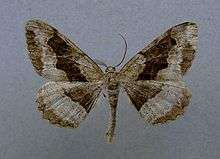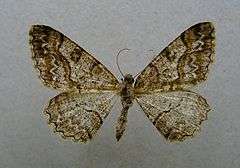Mottled beauty
The mottled beauty (Alcis repandata) is a moth of the family Geometridae. The species was first described by Carl Linnaeus in his 1758 10th edition of Systema Naturae.
| Mottled beauty | |
|---|---|
_Mottled_Beauty_(Alcis_repandata)_(14365205935).jpg) | |
| Scientific classification | |
| Kingdom: | Animalia |
| Phylum: | Arthropoda |
| Class: | Insecta |
| Order: | Lepidoptera |
| Family: | Geometridae |
| Genus: | Alcis |
| Species: | A. repandata |
| Binomial name | |
| Alcis repandata | |
| Synonyms | |
| |
Subspecies and forms
Subspecies and forms include: [1]

- Alcis repandata muraria
- Alcis repandata repandata
- Alcis repandata sodorensium
- Alcis repandata f. conversaria
- Alcis repandata f. nigricata
Distribution
Alcis repandata is a common species of Europe and the Near East, extending throughout Europe to the Urals, in the south over the Mediterranean, Asia Minor, the Caucasus to Kazakhstan and in the north to the Arctic Circle. [2]
Habitat
The species inhabits deciduous, mixed and coniferous forests, bushy heaths, meadows, marshes and settlement areas. In the Alps occurs up to 1800 meters.
Description
.jpg)
Alcis repandata has a wingspan reaching 30–45 mm. [3] This is an extremely variable species, [3] typically being buff or grey with black bars along the costa, but often with a broad blackish band across the forewings.
Melanic forms are also common, especially in industrial areas. In all but the darkest variations the most characteristic feature is a pale zigzag line across the hindwing.
This species is rather similar to Willow Beauty ( Peribatodes rhomboidaria).
Biology
This moth flies at night in June and July and is attracted to light. [3]
The larva feeds on the leaves and soft bark of a wide range of trees and other plants[3] (see list below).
The species overwinters as a small larva.
- ^ The flight season refers to the British Isles. This may vary in other parts of the range.
Recorded food plants
Host plants include:[4]
Gallery
_-_Mottled_beauty_(caterpillar)_-_%D0%94%D1%8B%D0%BC%D1%87%D0%B0%D1%82%D0%B0%D1%8F_%D0%BF%D1%8F%D0%B4%D0%B5%D0%BD%D0%B8%D1%86%D0%B0_%D0%B8%D0%B2%D0%BE%D0%B2%D0%B0%D1%8F_(%D0%B3%D1%83%D1%81%D0%B5%D0%BD%D0%B8%D1%86%D0%B0)_(40205895544).jpg) Caterpillar
Caterpillar_-_%D0%94%D1%8B%D0%BC%D1%87%D0%B0%D1%82%D0%B0%D1%8F_%D0%BF%D1%8F%D0%B4%D0%B5%D0%BD%D0%B8%D1%86%D0%B0_%D0%B8%D0%B2%D0%BE%D0%B2%D0%B0%D1%8F_(%D0%BA%D1%83%D0%BA%D0%BE%D0%BB%D0%BA%D0%B0)_(40205895454).jpg) Chrysalis
Chrysalis- Imago
 Mounted specimen
Mounted specimen
References
- Chinery, Michael Collins Guide to the Insects of Britain and Western Europe 1986 (Reprinted 1991)
- Skinner, Bernard Colour Identification Guide to Moths of the British Isles 1984
External links
| Wikispecies has information related to Mottled beauty |
| Wikimedia Commons has media related to Mottled beauty. |
- Alcis repandata - Biodiversity Heritage Library - Bibliography
- Lepiforum e.V.
- Paolo Mazzei, Daniel Morel, Raniero Panfili Moths and Butterflies of Europe and North Africa